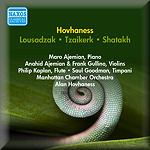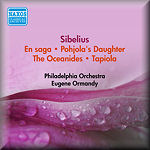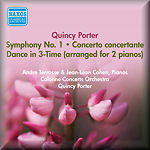As a bit of a Neanderthal when it comes to
downloads and mp3s it took a chance discovery, courtesy of Google,
to force me to reconsider.
I was doing some research on various versions
of the Franz Schmidt Fourth Symphony – the one that many will
know from the Decca/VPO/Mehta recording from circa 1972. I had
heard of an earlier mono recording by Rudolf Moralt so I Googled
for it.
I found that it had been issued on LP in the
1950s on one of the labels associated with CBS: Epic
LC-3164 (mono).
I then found http://www.naxos.com/catalogue/item.asp?item_code=9.80262
When I started the search I had no expectation
of finding a way of listening to it – still less a way of downloading
it via ClassicsOnline.
http://www.classicsonline.com/catalogue/product1.aspx?pid=561275
Curious as to what else might be there I found
this introduction from Naxos:-
“Naxos Classical Archives has an extensive list
of digitally transferred historical recordings. These include:
Bartók’s Music for Strings, Percussion and Celesta and
Stravinsky’s Song of the Nightingale from the Amsterdam
Concertgebouw Orchestra conducted by Eduard van Beinum (1955/1956);
Beethoven’s Third Piano Concerto from Claudio Arrau, the Philadelphia
Orchestra and Eugene Ormandy (1953); and David Oistrakh’s 1955
recording of Mendelssohn’s Violin Concerto and Mozart’s Violin
Concerto No. 4, also with Ormandy and the Philadelphia Orchestra.
All recordings on Naxos Classical Archives are available for
streaming and downloading only.”
Then go to a very long page listing everything
that is available:-
http://www.naxos.com/labels/naxos_classical_archives-cd.htm
OK so quite a few of these things have been reissued
on CD but perhaps as many as 55% - an impressionistic figure,
by the way - have never seen the light of silvery day.
See my eccentric extract want-list is at the
end of this review. I have hopes of doing a related feature
on other of these downloads.
There’s a lot more than I have listed – a mix
of the abstruse and the classics but in usually unfamiliar recordings.
Through the generosity of a fellow reviewer
I was able to hear a selection of these downloaded onto CDR.
Very honest and often handsome they sound too.
Playing time for each item reflects the total
play duration of the LP – in the 1950s: between 30 and 60 minutes.
Let’s take the three Hovhaness collections. They
are:-
Alan HOVHANESS
The Flowering Peach / Is There Survival / Orbit No. 1 9.80130
(1955) [42:09]
 The
Flowering Peach, Op. 125 (I. Overture; II. Lifting of
Voices and Building of the Ark; III. Intermezzo; IV. Rain; V.
Love Song; VI. Sun and Moon; VII. Rainbow Hymn)
The
Flowering Peach, Op. 125 (I. Overture; II. Lifting of
Voices and Building of the Ark; III. Intermezzo; IV. Rain; V.
Love Song; VI. Sun and Moon; VII. Rainbow Hymn)
Campbell, Kirby, saxophone; Portnoy, Bernard, clarinet; Lawrence,
Lucile, harp; Masselos, William, celesta; Castka, Joseph, tam-tam;
Goldenberg, Morris, timpani; Goldenberg, Morris, vibraphone;
Hovhaness, Alan, Conductor
Is There Survival (King Vahaken), Op. 59 (I. Overture;
II. Canon; III. Canon; IV. Aria; V. Fugue; VI. Fantasy; VII.
Double Canon)
Glantz, Harry, trumpet; Crisara, Raymond, trumpet; Prager, Nathan,
trumpet; Falcone, Frank, trumpet; Weber, David, clarinet; Glantz,
Fred, clarinet; Williams, Alexander, clarinet; Glassman, Karl,
clarinet; Dorn, William, percussion; Freeman, Harold, percussion;
Borodkin, Sam, percussion; Hovhaness, Alan, Conductor
Orbit No. 1, Op. 90, No. 2
Wilkins, Frederick, flute; Lawrence, Lucile, harp; Masselos,
William, celesta; Goldenberg, Morris, percussion; Castka, Joseph,
percussion; Hovhaness, Alan, Conductor
This is fascinating because of the rarity of
the material. It’s the most orientally plangent of the three
collections. Each of the three pieces is presented with separate
tracks for each section of each piece. The Flowering Peach
is a precious mystery with the sinuous saxophone – a strong
presence throughout - offset by the vibraphone singing out as
it also does at the peak of Roy Harris’s Symphony No. 7. There’s
mystical tension conjured from gong, bells, vibraphone and harp.
The most sheerly delightful movement is the Love Song. The final
segment – Rainbow Hymn – has a Schoenbergian awed stillness
about it. Is There Survival has less stillness
and more humming terpsichorean movement in the dazzling rhythmic
manner of St Vartan touched with the music of Morocco.
The Fugue makes Gabrielian play with a melody suggestive
of Medieval yuletide. Orbit is for a smaller group
leaning on the liquid movement of some invocation of otherworldly
awe. In each work the ensemble is conducted by the composer
which lends authenticity and authority to what we hear. The
sound is good. As with all of these Archive offerings there
are no liner notes. It is taken from MGM E3164(LP).
 Alan
HOVHANESS Lousadzak / Shatakh / Achtamar / Tzaikerk (1950)
9.80676 [36:13]
Alan
HOVHANESS Lousadzak / Shatakh / Achtamar / Tzaikerk (1950)
9.80676 [36:13]
Hovhaness, Alan, Conductor • Kaplan, Philip, flute • Manhattan
Chamber Orchestra • Ajemian, Maro, piano • Goodman, Saul, timpani
• Ajemian, Anahid, violin • Gullino, Frank, violin: Lousadzak,
Op. 48 for piano, violin and chamber orchestra; Shatakh,
Op. 73b for piano and violin; Achtamar, Op. 64,
No. 1 for solo piano; Tzaikerk, Op. 53 for violin,
flute, timpani and chamber orchestra.
This is derives from the oldest of the LPs represented
here: Dial Records
- dial 6(LP) yet it sounds in rude heath and suavely puts across
subtle effects such as the pizzicato chill rain-patter under
the storm-clouds piano in Lousadzak. The sisters
Maro (1921-1978) and Anahid (b. 1924) Ajemian, fellow Armenians,
co-founded with Hovhaness the Friends
of Armenian Music Committee which in the 1940s mounted celebrity
concerts in New York. These marked Hovhaness’s ascent to international
celebrity. The Ajemians tackle Shatakh which shows
the composer in subdued prayerful-lyrical form over the pearly
insistence of the piano. Maro explores the dark slow-boiling
threat of the Achtamar – like a picture of some
dark fathomless lake. Marvellous to hear the composer as conductor in the cool,
light disseminating Tzaikerk and the night-to-sun-dance
Lousadzak. Recording quality is slightly crumbly towards
the end of Lousadzak but otherwise surprisingly excellent.
 Alan
HOVHANESS Symphony No. 9, Op. 80, "Saint Vartan"
(1956) 9.80698 [41:07] Surinach,
Carlos, Conductor • MGM Orchestra • Masselos, William, piano
• Abato, Vincent J., saxophone • Di Biase, Neil, trombone •
Weiss, Theodore, trumpet. Parts 1-3 [24:41]; Parts 4-5 [16:26]
Alan
HOVHANESS Symphony No. 9, Op. 80, "Saint Vartan"
(1956) 9.80698 [41:07] Surinach,
Carlos, Conductor • MGM Orchestra • Masselos, William, piano
• Abato, Vincent J., saxophone • Di Biase, Neil, trombone •
Weiss, Theodore, trumpet. Parts 1-3 [24:41]; Parts 4-5 [16:26]
Wonderful that the this MGM LP (MGM E3453) has
found a new life. On the plus side one of the most instantly
accessible of Hovhaness’s approaching 70 symphonies is heard
in its pioneering recording. The performance appears very sympathetic.
The work is typically episodic yet has a grand arching tableau-style
action. Hieratic, terpsichorean in a stylised liturgical way,
modal, Tallis-like, intensely serious, subdued, not in any respect
vulgar. In all points it is suitable as tribute to the Armenian
warrior priest St Vartan. Other composers come to mind including
Andrea Gabrieli, Handel, Vaughan Williams, Roy Harris and Sibelius
but Hovhaness stamps his identity on this work. Add to this
a crashing ‘barbarous’ element. It lacks two of his DNA traces
though: the swooning slaloming violin notes of the Fra Angelico
overture and the dissonant awe of the Vishnu, Ani
and Odysseus symphonies (19, 23, 25). Although here
rendered in two tracks the work comprises a mosaic of dances,
arias, laments, estampies, yerks and tapors. There are 24 episodes
organised into five parts. Impressions crowd in: the priestly
precentor role of the trombone, the perpetuum mobile of
crashing and yelping trumpets and percussion, the serenely moving
strings, the indulgence in iterative musical cells, the plangent
pizzicato writing, the dissonant fanfares and the bladed onrush
of the violins (tr. 1, 9:07). This performance takes about 3
minutes longer than the composer’s own version made in the early
1970s in London with the National Philharmonic (Crystal
CD 802). The recording is strong but with the passage of
the years is not as clean as the chamber works presented in
the other two collections.
Has anyone ever drawn up a complete discography
of the MGM classical LPs? I would love to see a full list.
The two non-Hovhaness mono items:-
 Jean
SIBELIUS Four tone poems – Philadelphia/Ormandy from
1955 – 9.80351 – 54:05.
Jean
SIBELIUS Four tone poems – Philadelphia/Ormandy from
1955 – 9.80351 – 54:05.
This is classic Sibelius and I urge you to hear
this if you have a serious regard for Sibelius. A taut, fast
pulsed, urgently-singing, creepily charged, breathlessly fleeing
yet spot-on accurate En Saga which is to be counted in
the company of the different but equally special En Sagas
from Van Beinum (Eloquence), Furtwängler (Music and Arts) and
Stein (Decca). By the way was that a cough at 5:56? Ormandy’s
Pohjola’s Daughter is treacle dark without undue sweetness
or becoming bogged down. The representation of the pulsing,
shivering rainbow in the Vainamoinen story is as potent as any.
Classic Sibelius. Incidentally my most recent encounter with
Pohjola’s Daughter was in a surprising context. How many
of you recall BBCTV’s The Onedin Line from the 1970s?
The first episode was rebroadcast recently. It is well known
for its use and indeed elevation to fame of Khachaturian’s Adagio
from Spartacus. What may be less recalled is that
it used ‘modern’ classical works as incidental music. I wonder
who it was in the production team selected Pohjola’s Daughter
which is used twice in episode 1. Later episodes deployed
Bax’s November Woods and the Moeran G minor Symphony
among much else. Speaking of marine matters: Ormandy’s Oceanides
is fast to the point where the sultry flute playing can
sound rushed. In doing so Ormandy moves the locale from the
Mediterranean to the Baltic. Beecham took 10:23 in the late
1950s. His Tapiola is never far away from menace or anger.
This is not as impressive as Van Beinum (Eloquence) who really
lights up every bar of the score but it’s good and never slack
or too plush despite the illustrious instrumental riches Ormandy
had at his bidding. This collection was taken from a Columbia
Masterworks LP ML-5249.
Ormandy-Sibelius reminiscences
here and here.
 Quincy
PORTER (1897-1966) – orchestral works – Colonne Concerts/composer
from 1955 – 9.80674 – 50:32.
Quincy
PORTER (1897-1966) – orchestral works – Colonne Concerts/composer
from 1955 – 9.80674 – 50:32.
American composer Porter studied in Paris with
d’Indy. His 1934 symphony no. 1 is in three movements. It is
heard here in a Parisian recording. The recording has a tough
strident edge to it but can sound smoother and cooler. Cool
is the word for the emotionalism of this piece. It has a calming
passion-softened neo-classical edge to it – emotional, yes …
but avoiding the wilder extremes. Its gentle jazziness can remind
us of Constant Lambert. It’s a pleasing piece and as an interpretation
a degree warmer than that of Sinfonia Varsovia/Ian Hobson on
Albany
TROY574. The Concerto Concertante introduces André
Terrasse and Jean-Leon Cohen as the pianists in this subtly
suggestive piece, harmonically ambivalent dream-like piece which
yet ends in an explosion of urgency. There’s some congestion
and a degree of boxiness here but nothing untoward. The short
Dance in Three-Time has a hint of Ibert’s Escales
exotica, dark alleys, danger and pleasure and the Marrakesh
soukh. There are Hispanic flavours as well and these go beyond
the use of castanets. All ends in a sigh and a hazy heat. Delightful.
Taken from Overtone LP #10.
I recommend this service strongly. In the UK
it’s only £1.99 per item straight into your computer or MP3
player.
There are some pretty wonderful recordings available
for free downloads via some of the newsgroups and occasionally
some composer and enthusiast websites offer free downloads.
The newsgroup I am most familiar with is rec.music.classical.recordings
(rmcr) which often offers downloads through Mediafire and other
download sites.
The internet is a seethingly lavish canvas
in kaleidoscope motion and colour and texture. One of my latest
discoveries is The Gramophone’s website giving access to what
seems to be every issue since the launch in 1923 and the ability
to search – all free – no subscription at all.
Try:
http://www.gramophone.net/
and explore from there. Here’s the URL for
a sample review from 1960:-
http://www.gramophone.net/Issue/Page/June%201960/42/784229
I confess to being no fan of what Gramophone
has become since the early 1980s but this is a truly enlightened
move. I rather wonder how long it will remain free access. An
admirable and relentlessly adventurous magazine that continues
in better health is the US bimonthly, Fanfare. For some time
their complete archive back to 1977 was available free online.
It has now become subscription only. Will Gramophone.Net go
the same way.
For now do have a look at the Naxos Classical
Archive – there are some smiles, revelations, train-wrecks and
delights there. Exciting stuff – we could do with more of this.
I keep hoping that someone will make accessible
the Pancho Vladigerov recordings issued in three staggeringly
heavy Bulgaroton LP boxes in the 1970s. Then what about the
symphonies of Cuclin, Revutsky, Adolfs Skulte (a strong prospect
– mark my words), Marx, Fordell and so many others. Enthusiasts
with the necessary resources should look at what has been achieved
with free downloads for Machavariani
and Lokshin.
Rob Barnett
EXTRACT FROM CLASSICS ONLINE LIST
RACHMANINOV: Bells (The) / Isle of the Dead
(Ormandy) (1954) 9.80114
SLAVENSKI, J.: Sinfonia Orienta (Zdravkovich)
(1955) 9.80116
WAGENAAR, B.: Symphony No. 4 (American Recording
Society Symphony, Haeffner) (1952) 9.80694
RASSE, F.: Violin Concerto / JONGEN, J.: Piano
Concerto (Hosselet, Pueyo) (1955) 9.80132
RAVEL: Ma mere l'oye / Rhapsodie espagnole
(Inghelbrecht) (1955) 9.80216
PIJPER, W.: Symphony No. 3 / DIEPENBROCK, A.:
Marsyas or The Enchanted Well (excerpts) (Beinum) (1953)
9.80309
HENKEMANS, H.: Violin Concerto / PIJPER. W.:
Piano Concerto / 6 Symphonische Epigrammen (Beinum) (1954)
9.80310
BLOCH, E.: Concerto Grosso No. 1 / SCHUMAN,
W.: Symphony No. 5, "Symphony for Strings" (Steinberg)
(1952) 9.80155
GOEB: Symphony No. 3 / BARTOK: Sonata for 2
Pianos and Percussion (Stokowski) (1952) 9.80215
MENNIN, P.: Symphony No. 3 / RIEGGER, W.: Symphony
No. 3 / SESSIONS, R.: Symphony No. 2 (Hanson, Mitropoulos) (1954)
9.80248
SCHMIDT, F.: Symphony No. 4 (Moralt) (1955)
9.80262
SIBELIUS, J.: Lemminkainen Suite (Ormandy)
(1951) 9.80350
SKALKOTTAS, N: 36 Greek Dances (excerpts) (Millar)
(1957) 9.80443
SURINACH, C.: Sinfonietta flamenca / TURINA,
J.: Sinfonia sevillana (Winograd) (1957) 9.80447
BRANT, H.: Alto Saxophone Concerto (Rascher,
T. Johnson) / GLANVILLE-HICKS, P.: 3 Gymnopedie / RUDHYAR, D.:
Sinfonietta (RIAS Symphony, Perlea) (1953) 9.80647
CHADWICK, G.W.: Tam O'Shanter / CONVERSE, F.S.:
The Mystic Trumpeter (American Recording Society Symphony, Schoenherr)
(1952) 9.80658
HAIEFF, A.: Piano Concerto No. 1 / WARD, R.:
Symphony No. 1 (Smit, American Recording Society Symphony, Hendl,
Dixon) (1952) 9.80659
SOWERBY, L: Prairie / From the Northland (American
Recording Society Symphony, Dixon) (1952) 9.80660
HARRISON, L.: Suite for Violin, Piano and Small
Orchestra / WEBER, B.: Symphony on Poems of William Blake (Stokowski)
(1952) 9.80675
COWELL, H.: Symphony No. 7 / WARD, R.: Adagio
and Allegro / Jubilation Overture (Vienna Symphony, Strickland)
(1955) 9.80679
KARLOWICZ, M.: Violin Concerto / MACHAVARIANI,
A.: Violin Concerto (Barinova, Vaiman) (1955-1956)
9.80683
ROSENBERG, H.: Symphony No. 3, "De fyra
tidsaldrarna" (The Four Ages of Man) (Stockholm Symphony,
Mann) (1953) 9.80751
GLANVILLE-HICKS: Etruscan Concerto / HOLMBOE:
Concerto No. 11 (Surinach) (1956) 9.80083
GLAZUNOV, A.: Symphony No. 4 / KABALEVSKY,
D.: Symphony No. 2 (Rachmilovich) (1949) 9.80125
RAVEL: Bolero / La valse / Pavane pour une
infante defunte / IBERT: Escales / DEBUSSY: Clair de lune /
CHABRIER: Espana (Ormandy) (1953-1954) 9.80259

